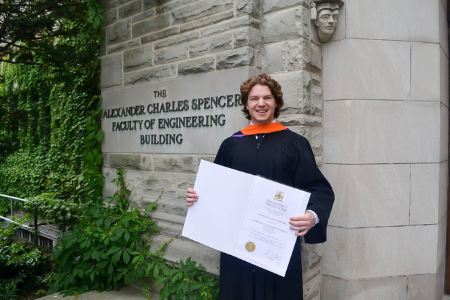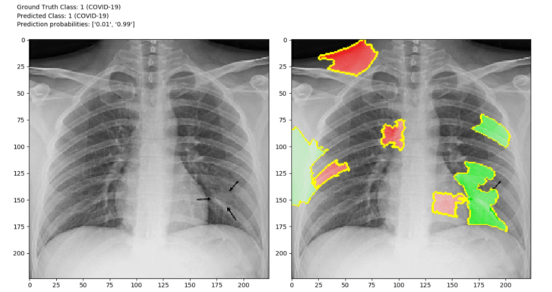Media
Contact
Communications Specialist
Faculty of Engineering
Spencer Engineering Building
Room 2072
Western University
Tel: 519-661-2111 ext. 87015
Email: engineeringcomms@uwo.ca
Alumnus investigates machine learning to predict COVID-19 cases from chest X-rays
Western Engineering News | May 5, 2020
 As our campus community continues to support the fight against COVID-19 and encourage one another through these challenging times, we know our alumni are doing the same in their own communities.
As our campus community continues to support the fight against COVID-19 and encourage one another through these challenging times, we know our alumni are doing the same in their own communities.
That’s why Western Engineering reached out to its alumni to say, “We want to share your story.”
We received responses from alumni in a variety of careers who are contributing to their communities amidst COVID-19 in a variety of ways. Over the next few weeks, we’ll be sharing their stories.
Software Engineering graduate Blake VanBerlo, BESc’17, currently works as a Machine Learning Consultant for the Artificial Intelligence Research and Innovation Lab at the City of London’s Information Technology Services Division.
By repurposing code that was originally built for internal projects, VanBerlo and his colleagues are developing a machine learning model that automatically classifies chest X-rays of severe cases of COVID-19.
We caught up with Blake to learn more about his team’s work with the City and to find out how this machine learning model can benefit the healthcare industry in identifying new COVID-19 cases.
How did this project come to be?
When cases of COVID-19 started appearing in London, my colleague, Matt Ross, had the idea of using the lab’s infrastructure to apply machine learning to a problem related to COVID-19. A little over a month ago, we decided to investigate whether a machine learning model could be used to identify severe cases of COVID-19. Chest X-rays, although not the recommended means for diagnosis of COVID-19, are widely available. We figured that any insights derived from such an investigation might be useful to researchers and healthcare providers in London and elsewhere in the world.
Can you briefly explain your research and the overall goal of your work?
The overall goal of our research is to determine whether a machine learning model can accurately identify severe cases of COVID-19 by looking at chest X-rays. If this model can be developed, a secondary goal – but one that is just as important – is to understand the predictions made by the model. Many modern machine learning systems are “black boxes,” meaning that we cannot understand why the system makes a particular decision. By seeking explanations for the model’s predictions, we hope that healthcare providers may derive insight about the features of COVID-19 on chest X-rays. Additionally, explanations of model predictions promote transparency in machine learning and, hopefully, trust from healthcare providers.

An example of areas that most contributed toward a prediction of COVID-19. Colourized regions contributing toward (green) and against (red) prediction of COVID-19. VanBerlo’s team currently uses an algorithm called LIME (local interpretable model-agnostic explanations) to determine which areas in the image were most contributory toward the model’s predictions.
Who will the results impact?
Our project will hopefully impact clinicians and suspected severe COVID-19 patients in the London region and beyond. The intention is to develop a model for clinicians through the interaction between explainable machine learning and iterative clinician input. If the project is ever to have an impact in patient care, it must be designed with and validated by clinicians.
Note that this project is geared toward identification of patients with severe respiratory symptoms due to COVID-19. Many individuals who are sick from COVID-19 experience mild-to-no symptoms and are therefore excluded from our work.
This work will impact other machine learning researchers who are concurrently working on the same problem elsewhere in the world. We have made our code publicly available, and we invite other researchers to use it as a starting point for their work.
What are your overall feelings about the potential impact of your team’s work?
I am optimistic that my team’s work will contribute to the growing body of knowledge surrounding the diagnosis and management of COVID-19. As an engineer, I am very honoured and excited to be working on a project that can deliver a potential social impact during this sensitive time.
We are aware that others are attempting to build on top of the code that we have posted, which strengthens my feeling that something good will come of our work. Although we have obtained promising results so far, I am also feeling cautious, as we truly do not know the practical value of our work until clinicians assess it, and we don’t wish to make any embellished claims about the diagnosis of COVID-19.
For supplementary information on VanBerlo’s research, the following articles further explain his team’s work thus far:
- How to use COVID-CXR to Identify COVID-19 Infection on Chest X-rays with Explainable Machine Learning
- Investigation of Explainable Predictions of COVID-19 Infection from Chest X-rays with Machine Learning
- COVID-CXR: An open source explainable deep CNN model for predicting the presence of COVID-19 in chest X-rays

